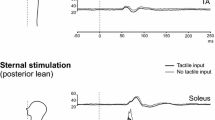Summary
Postural readjustment to body sway, induced by vibration applied to leg muscles for 30 or 40 s, was investigated in healthy subjects standing erect on a gravicorder. The vibratory stimulus induced involuntary body sway in the same direction as the vibrated side, and after cessation of vibration, the body swayed in the opposite direction beyond the initial standing position. Body sway consisted of a sustained displacement with gradual onset, upon which were superimposed some oscillatory movements.
An increase in discharge of the soleus muscles was not obvious when vibration was applied to the Achilles tendon of a standing subject. However, vibration could provoke a tonic activity in the soleus muscles under the following conditions: (1) when the muscle was maintained in an isometric contraction, or (2) when the muscle was stretched voluntarily by leaning forward. It was found that EMG activity in the soleus muscles correlated well with the position of the center of gravity of the body. During vibration, an enhancement of the EMG activity was roughly proportional to the magnitude of the body inclination. These enhancements can be explained as the tonic vibration reflex (TVR), and body inclination induced by vibration may be partially explained as the TVR phenomenon.
An ischemic nerve block of the legs reduced the vibration-induced body sway and the Achilles tendon reflex (ATR). The time courses of suppression and recovery after the release of the nerve block were compared: (a) the backward body inclination induced by the Achilles tendon vibration became obscure after 9–12 min of ischemia, and it took 6–12 min for recovery, and (b) the amplitude of the ATR decreased more gradually than that of body inclination and diminished after 20 min of ischemia, but it recovered very rapidly (within approximately 1 min). The discrepancy between these time courses suggested that afferent fibers which take part in body sway are not only group Ia fibers, but also smaller ones such as group II and cutaneous afferents.
Frequency analysis of body sway during postural readjustments to the vibratory stimulus showed: (1) a marked increase in amplitude for the low frequencies (less than 0.2 Hz) that reflected body inclination; and (2) sharp spectral peaks between 0.2 Hz and 0.8 Hz that reflected oscillatory movements.
Similar content being viewed by others
References
Abbruzzese G, Hagbarth KE, Homma I, Wallin U (1978) Excitation from skin receptors contributing to the tonic vibration reflex in man. Brain Res 150: 194–197
Burke D, Hagbarth KE, Löfstedt L, Wallin BG (1976a) The responses of human muscle spindle endings to vibration of non-contracting muscles. J Physiol (Lond) 261: 673–693
Burke D, Hagbarth KE, Löfstedt L, Wallin BG (1976b) The responses of human muscle spindle endings to vibration during isometric contraction. J Physiol (Lond) 261: 695–711
Burke D, Eklund G (1977) Muscle spindle activity in man during standing. Acta Physiol Scand 100: 187–199
Eklund G (1972) General features of vibration-induced effects on balance. Ups J Med Sci 77: 112–124
Eklund G (1973) Further studies of vibration-induced effects on balance. Ups J Med Sci 78: 65–72
Fox JL, Kenmore PI (1967) The effect of ischemia on nerve conduction. Exp Neurol 17: 403–419
Goodwin GM, McCloskey DI, Matthews PBC (1972) The contribution of muscle afferents to kinaesthesia shown by vibration induced illusions of movement and by the effects of paralysing joint afferents. Brain 95: 705–748
Hagbarth KE, Vallbo ÅB (1968) Discharge characteristics of human muscle afferents during muscle stretch and contraction. Exp Neurol 22: 674–694
Hagbarth KE, Wallin G, Löfstedt L (1975) Muscle spindle activity in man during voluntary fast alternating movements. J Neurol Neurosurg Psychiatry 38: 625–635
Heinbecker P (1929) Effect of anoxemia, carbon dioxide and lactic acid on electrical phenomena of myelinated fibers of the peripheral nervous system. Am J Physiol 89: 58–83
Mackenzie RA, Burke D, Skuse NF, Lethlean AK (1975) Fibre function and perception during cutaneous nerve block. J Neurol Neurosurg Psychiatry 38: 865–873
Magladery JW, McDougal DB, Stoll J (1950) Electrophysiological studies of nerve and reflex activity in normal man. II. The effects of peripheral ischemia. Bull Johns Hopkins Hosp 86: 291–312
Moddel G, Best B, Ashby P (1977) Effect of differential nerve block on inhibition of the monosynaptic reflex by vibration in man. J Neurol Neurosurg Psychiatry 40: 1066–1071
Sinclair DC (1948) Observations on sensory paralysis produced by compression of a human limb. J Neurophysiol 11: 75–92
Vallbo ÅB (1971) Muscle spindle response at the onset of isometric voluntary contractions in man. Time difference between fusimotor and skeletomotor effects. J Physiol (Lond) 218: 405–431
Vallbo ÅB (1974) Human muscle spindle discharge during isometric voluntary contractions. Amplitude relations between spindle frequency and torque. Acta Physiol Scand 90: 319–336
Author information
Authors and Affiliations
Rights and permissions
About this article
Cite this article
Hayashi, R., Miyake, A., Jijiwa, H. et al. Postural readjustment to body sway induced by vibration in man. Exp Brain Res 43, 217–225 (1981). https://doi.org/10.1007/BF00237767
Received:
Issue Date:
DOI: https://doi.org/10.1007/BF00237767




